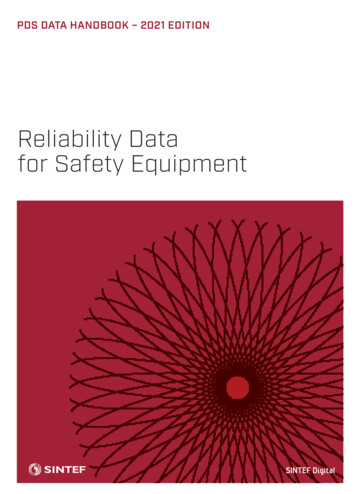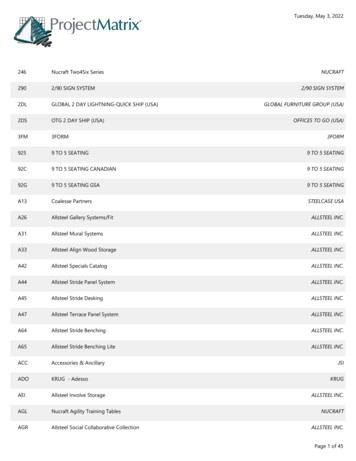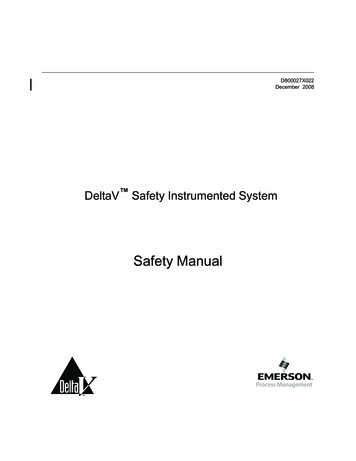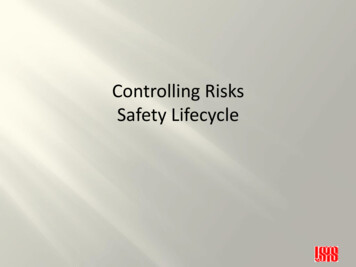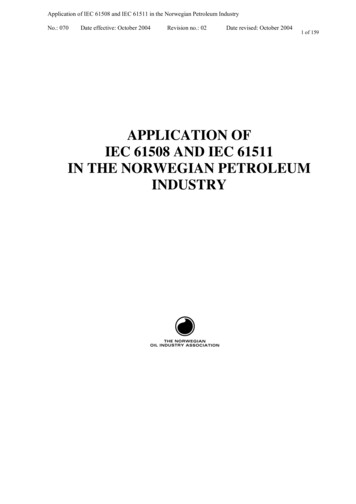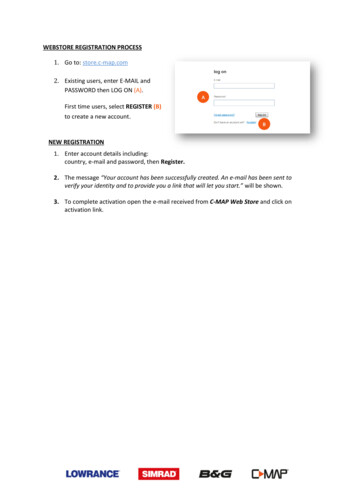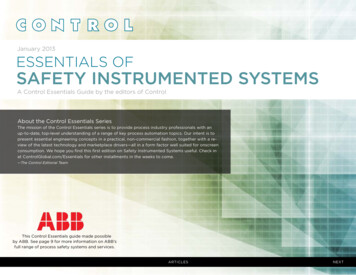
Transcription
January 2013Essentials ofSafety Instrumented SystemsA Control Essentials Guide by the editors of Control About the Control Essentials SeriesThe mission of the Control Essentials series is to provide process industry professionals with anup-to-date, top-level understanding of a range of key process automation topics. Our intent is topresent essential engineering concepts in a practical, non-commercial fashion, together with a review of the latest technology and marketplace drivers—all in a form factor well suited for onscreenconsumption. We hope you find this first edition on Safety Instrumented Systems useful. Check inat ControlGlobal.com/Essentials for other installments in the weeks to come.—The Control Editorial TeamThis Control Essentials guide made possibleby ABB. See page 9 for more information on ABB’sfull range of process safety systems and services.Articlesnext
ExecutiveSummaryThroughout the global process and energy industries, the safety instrumented system(SIS) plays an essential role in protecting workers and equipment as well as nearbycommunities and the environment from harm. Much has changed in the severaldecades since the first programmable systems for safety protection were developed and deployed, and today the discipline continues to evolve and advance in terms of both methodology and technology.The key reference methodology that has emerged for managing safety instrumented systems over their entire lifecycle—from risk assessment through design, operations and maintenance—are the IEC’s 61508 and 61511 international standards. The standards originallywere developed by industry for industry as technical standards. But in some arenas, compliance with the standards already carries the force of law. And even in areas where theyare not legislated, the standards’ growing acceptance as descriptors of best practices meansthat non-compliance may have very real liability implications if something does go wrong.The standards themselves are purposely performance-based: they allow engineers theflexibility to meet industry and society’s safety expectations in more than one way. Indeed,from a technology perspective, today’s digital SIS options increasingly leverage integrationand diagnostics to boost safety, availability and productivity even while reducing cost andcomplexity for end users. But the extent to which safety and control should be integratedor remain separate without compromising safety remains a subject of heated discussion.For their part, many independent consultants take the side of the standards and the math:integration doesn’t necessarily compromise safety protections, but suppliers and their usersneed to adequately demonstrate that is indeed the case.Further complicating the SIS landscape is the fact that many of industry’s installationspredate current standards, and verifying that older systems perform—and continue to perform—to standard is a significant undertaking. Indeed, many first and second generationinstallations are at or beyond the end of their serviceable lives and need to be migrated tomore current technology.Bottom line, the engineering of safety instrumented systems remains a complex andsubtle task. And once commissioned, both proactive work processes and ongoing corporatecommitment are needed to assure that SIS protections do not degrade over time.previousArticlesnext
SIS in a Process Safety ContextSafety is at its core an exercise in risk management. And safety instrumented systems provide but one layer ina holistic, multi-layered approach designed to reduce risk not to an ideal but unachievable zero, but to a leveldeemed “as low as reasonably practicable” (ALARP).Even at this early stage, a necessary level of subjectivity enters into safety calculations, as risk analysis must firstendeavor to quantify the consequences of all potential risks as well as their likelihood of occurrence. Multiplyingthe severity of consequence by frequency of occurrence (in absence of any protective measures) in turn allows one toquantify potential risks so each can be appropriately addressed. Depending on the level of risk and complexity of operations involved, this often entails a rigorous hazards and operability (HAZOP) study involving a multi-disciplinaryteam of process, electrical, mechanical, instrumentation and safety professionals.Measures of first resort for reducing risk include changes to the process and the equipment itself—for example,through using a solvent that is less toxic or a vessel with a higher pressure rating. For a given process design, then,protective layers may be needed to further address any gap between identified process risk and a level deemed acceptable. These protective measures are generally grouped into preventive layers, such as operator actions and automated emergency shutdown procedures, and mitigation layers such as pressure relief valves and emergency responseprocedures (Figure 1).In a simplified methodology appropriately referred to as layers-of-protection analysis (LOPA), the risk-reductioncontribution of each of these often overlapping layers of protection can be calculated, including the contribution ofa safety instrumented system if employed. Emergency response(plant, community) Passive protection(dike)Mitigate Active protection(relief valve, rupture disk) Automated shutdown(safety instrumented system)Prevent Operation intervention(basic process control system) Normal operation Process designFigure 1. Safety risks can be reduced atany of these protective layers.previousArticlesnext
Fundamental ConceptsIn the context of most process industry applications, safety instrumented systems are therejust in case— just in case the human operators and the basic process control system failto maintain process conditions within a safe operating envelope.Process alarms should first alert the operator to an escalating temperature or pressure,but if the operator is unable to address the problem, the SIS takes over, automaticallyshutting things down before an out-of-control process becomes an unsafe one. At its simplest, a dedicated safety instrument senses a potentially unsafe condition, communicateswith a safety logic solver which then activates a dedicated final control element (normally a valve) to effect a safe process shutdown (Figure 2.) In a refinery or other complexprocess facility, SIS loops can run into the dozens or hundreds.By design, then, safety instrumented systems spend most of their time idling about instand-by mode—so how can one be sure that when they’re called on to do their job theywill react in a timely and effective manner? And on the other side of the ledger, how doSensoryou ensure that a safety system doesn’t trip when a shutdown isn’t really needed? While notunsafe, spurious trips can put a substantial dent in process availability and ultimately company profitability. These essential and often contradictory demands on SIS performanceexplain why their design and upkeep remains a demanding yet critical task.Like most engineering specialties, the safety system vernacular is rife with useful terminology and shorthand that nevertheless can quickly intimidate the uninitiated. Two of themost useful concepts to understand are those of the safety instrumented function (SIF)and the safety integrity level (SIL). It’s easiest to think of a SIF as simply the action of thesimple safety loop described above, abstracted from implementation details. Safety integrity levels, in turn, describe the risk reduction achieved by a particular SIF or required bya particular application.SILs are assigned integer values from 1 to 4, with each level representing another order of magnitude increase in required risk reduction or decrease in probability of failureon demand, or PFD. SIL 1 describes anapplication with a risk reduction of 10 to100, which translates to 90-99% SIF availability. At the other end of the scale, SIL 4entails a required risk reduction of 10,000to 100,000, or a SIF availability of 99.99%to 99.999%. Translation: SIL 1, mildlyhazardous. SIL 4, extremely dangerous.Logic solverFinal control elementFigure 2. At its simplest, a safety instrumented system consists of a sensor, a logic solver (controller) and finalcontrol element.previousArticlesnext
Faults & Counter StrategiesTo ensure that safety systems continue to deliver their intended risk reduction while not eroding uptime, SIS designers have developed a variety of approaches over the years, includingredundancy, diversity, diagnostics and testing/inspection. All of these strategies are intendedto cope with a range of random, systematic and common cause faults that could result in an SIS nottripping when it’s needed—or tripping when it’s not.In the course of designing a new safety system—or evaluating an existing one—each type of faultfor every system component (together with the risk reduction strategies employed) must be classifiedaccording to its effect on safety system performance.Broadly speaking, faults are classified as safe or dangerous, and may be overt (apparent in normal operation), detected (as through diagnostics) or revealed (as through proof tests or periodic inspections).For detected and revealed faults, procedures must be in place to ensure that detected or revealed faultsare indeed addressed in a timely fashion. The time between proof tests and manual inspections as wellas the time needed to execute a repair also affect the overall SIS performance calculations.previousArticlesKey Types of Faults Random faults include the unpredictable failure of a system component, such as an electronics board. S ystematic faults are when a combination of conditions results in areproducible failure of the system and are most often attributableto software issues in programmable safety systems. C ommon cause faults are when a single external influence causesmore than one system component or layer of protection to fail. and Strategies for Coping Redundancy refers to the use of multiple parallel system componentsconfigured to back each other up if a failure in one component occurs. Redundancy often is used in conjunction with voting schemesand diagnostics to help verify which between two or among severalcomponents is operating correctly in the event of a fault. D iagnostics help improve safety system performance by identifyingthe presence of current or imminent faults in system componentsand in turn communicating that information back to operations andmaintenance personnel before SIS performance is compromised. Diversity is most often cited as a means to counter common causeand systematic failures and can refer to redundant functionality withinthe SIS itself and/or with respect to the basic process control system.Diversity can be applied to sensor technologies, I/O technologies, control and software platforms and even product development teams. Testing and inspection of safety system components can be performed manually or in an automated fashion to detect—and importantly, correct—current or imminent faults.next
The Safety LifecycleWthrough third-party certifications or actual historical data. And, much like the more fahile other industry-specific codes and standards apply to industrial safetymiliar ISO 9000 series of quality standards, they strongly emphasize the importance ofsystems, the IEC’s 61508 and 61511 international standards are the key docdocumentation at all lifecycle stages, such as the need to develop and maintain a clearuments relevant to safety instrumented systems developed and deployed forand unambiguous safety requirements specification.use within the global process industries. The standards originally were developed by industry for industry as technical standards. But in some arenas, compliance already carries the force of law. And even in areas where theyare not legislated, the standards’ growing acceptance as descriptorsPlanning & analysisof best practices means that non-compliance may have very real liDecommissioningability implications if something does go wrong.In addition to the functional safety concept, the IEC standardsoutline a holistic methodology for managing every stage of a safetyFront-endsystem’s lifecycle—from risk analysis and design engineeringengineeringManagementthrough operations, management of change and decommissioningof change(Figure 3).Included within the scope of the standards are such topics as alternative methods for gauging the reliability of system componentsOperations& maintenanceEngineeringdesignCommissioningFigure 3. The IEC’s 61508 and 61511 standards provide guidance for ensuring safetyinstrumented system performance at all stages of the safety lifecycle.previousArticlesnext
Integrated SafetyOne the most contentious areas in the SIS community today is at the intersection ofdiversity and integration. Some voices advocate for the continued complete physicalseparation of safety and control systems—preferably purchased from and developedby different supplier organizations. Others argue that given today’s technology and other riskreduction strategies, that logical or functional separation can reduce risk just as effectively asphysical separation.Integration, or at least “interfacing,” of safety systems with basic process control systems is infact not a new practice. Indeed, the standards’ non-prescriptive language doesn’t rule out eventhe physical integration of control and safety in the same box or on the same network. Rather,the standards assert that functional safety cannot be compromised by a failure or by maintenance activities associated with the basic process control system. Diagnostics technology, meanwhile, has advanced in its ability to intercept faults, and some of today’s integrated safety alternatives feature embedded diversity that reaches all the way back to separate development teams.previousSuppliers’ commercial interests also are at play. A supplier of historically stand-alone safetysystems might argue (understandably) that complete independence provides the greatest assurance of safe operation—and that they have the track record to prove it. Meanwhile, a supplier of both safety and control systems will (understandably) promote comparable safetyalong with the cost and productivity benefits to be gained by an integrated approach. Thesesystems, too, have a significant and growing installed base that can be referenced. For theirpart, third-party consultants tend to come down on the side of mathematics: the standardsprovide a way to quantify and document the risk reduction capability of either approach, andshould be the ultimate arbiter from a safety perspective.Bottom line, risks can be reduced in more than one way, and safe operations do not necessarily come at the expense of increased productivity and reduced complexity offered by integration. Third-party certifications and the existence of “proven in use” data from other similarinstallations can help make decision-making easier.Articlesnext
Acronyms & Definitions A s low as reasonably practicable (ALARP) sets the bar for the level to which riskis to be reduced to using protective measures. Basic process control system (BPCS) is the system routinely used by operators tocontrol and interact with the process. Dual modular redundant (DMR) is a voting scheme based on two redundant safetysys tem components. Equipment under control (EUC) refers simply to the process equipment in question. Failures modes, effects and diagnostic analysis (FMEDA) is a detailed methodology used to determine a parti cular application’s safety integrity level. Functional safety describes the logical separation of safety protections, or functions,from the systems that provide them. Functional safety management system (FSMS) describes the work processesand systems in place that are designed to maintain safety system protections over time. Hardware fault tolerance (HFT) refers to the ability of a functional unit to continueto perform its required function in the presence of faults or errors. Hazards and operability study (HAZOPS) is a detailed methodology for identifying and quantifying risks presented by a manufacturing process. Independent protection layers (IPL) are layers of risk reduction that operate independently of one another. Layers of protection analysis (LOPA) is a simplified risk assessment methodologythat attributes risk-reduction contribution to various independent prevention and mitigation measures. Probability of failure on demand (PFD) quantifies the probability that a safetysystem failure will cause the system to not respond as needed. Process hazards analysis (PHA) is the overarching methodology for qualifying andquantifying risks presented by a manufacturing or other industrial process. Programmable electronic system (PES) refers to any microprocessor-based safetyor control system. Quad modular redundant (QMR) is a voting scheme that features two pairs of redundant safety system components.previous S afety integrity level (SIL) refers to the level of risk reduction provided by a givensafety instrument function, or required by a given application. Safe failure fraction (SFF) is the portion of safety system failures that do not result ina loss of protective function. Safety instrumented function (SIF) is the risk-reducing action, or function, of asafety instrumented system loop, divorced from implementation details. Safety instrumented systems (SIS) are the hardware and software that performsafety instrument functions. Safety requirements specifications (SRS) spell out in detail the characteristics ofvarious safety instrumented functions required by a given application. Triple modular redundant (TMR) is a voting scheme based on three redundantsafety system components.Articlesnext
Made Possible by ABBThis Control Essentials guide on Safety Instrumented Systems was made possible by ABB, which over thepast 30 years has successfully delivered and installed safety systems in more than 55 countries worldwide.With operations on all continents and dedicated safety system teams around the world, ABB provides notonly highly-qualified technical resources during project delivery, but also ensures competent local supportand service in operation. ABB works hard with end-users to maintain and evolve existing installations,thereby maximizing customer value and ensuring safe plant operation.Learn more about ABB’s safety offering.previousArticles
EssEntials of Safety InStrumented SyStemS this control essentials guide made possible by ABB. see page 9 for more information on ABB's . afety is at its core an exercise in risk management. And safety instrumented systems provide but one layer in a holistic, multi-layered approach designed to reduce risk not to an ideal but unachievable .
